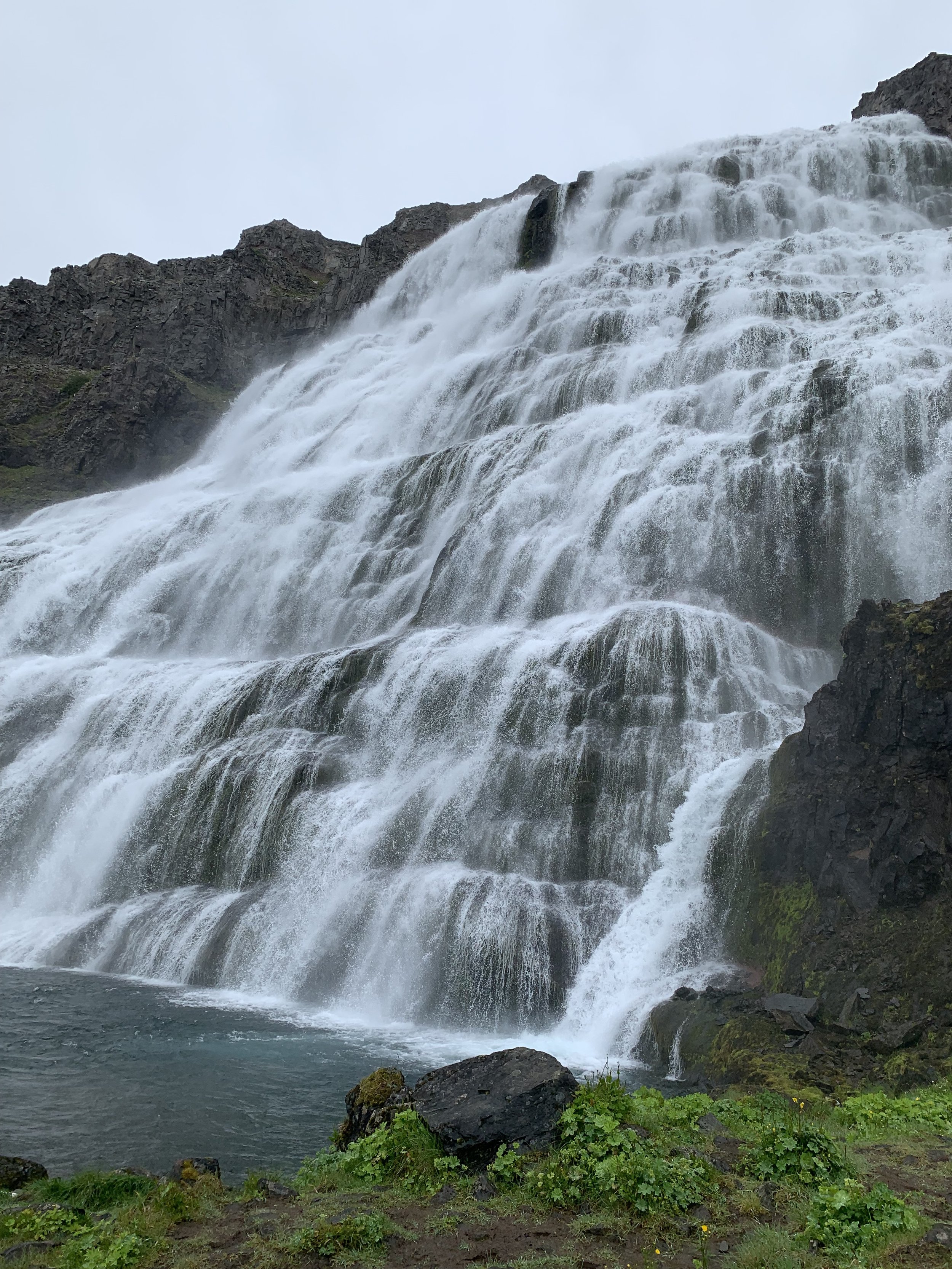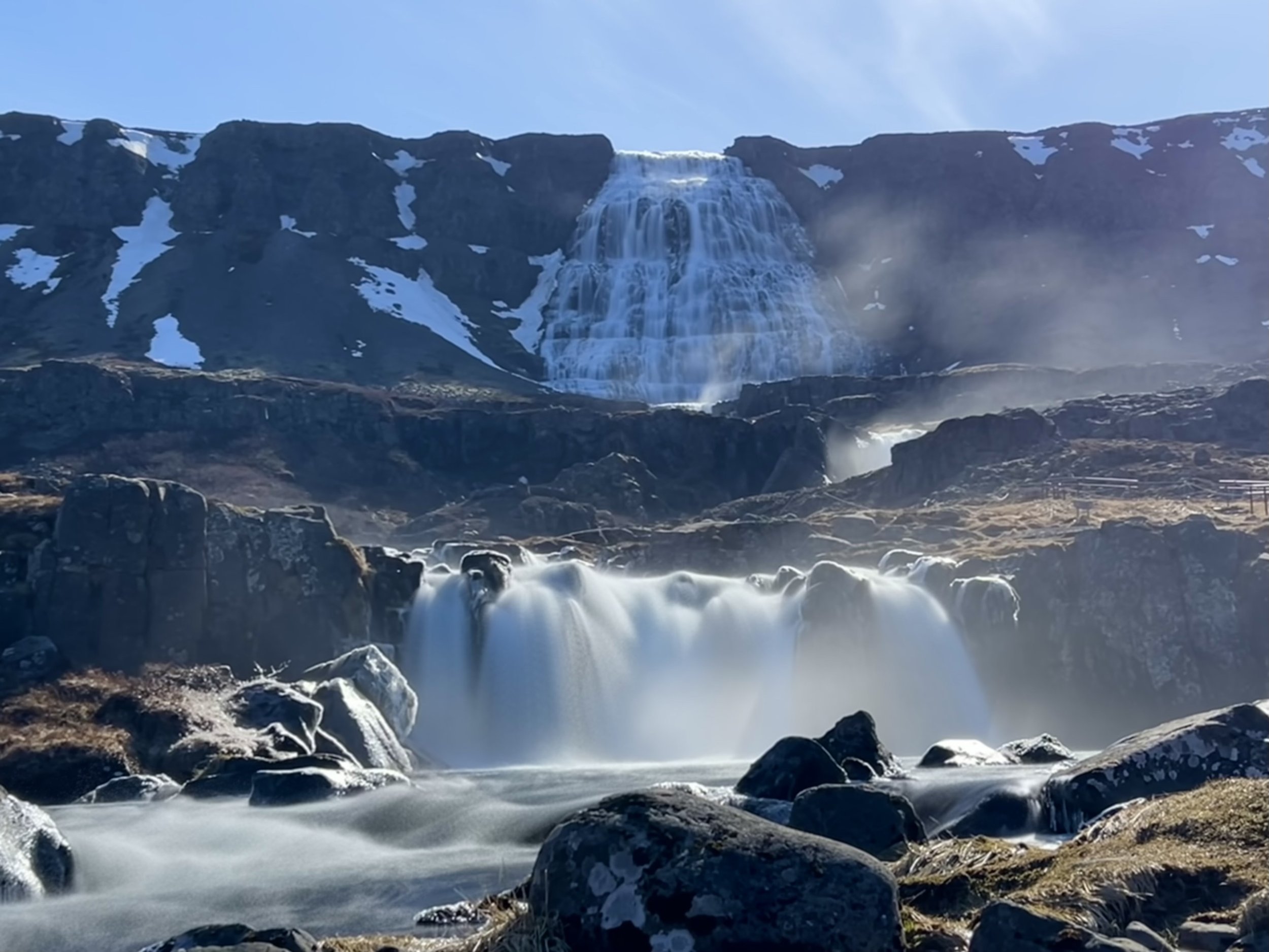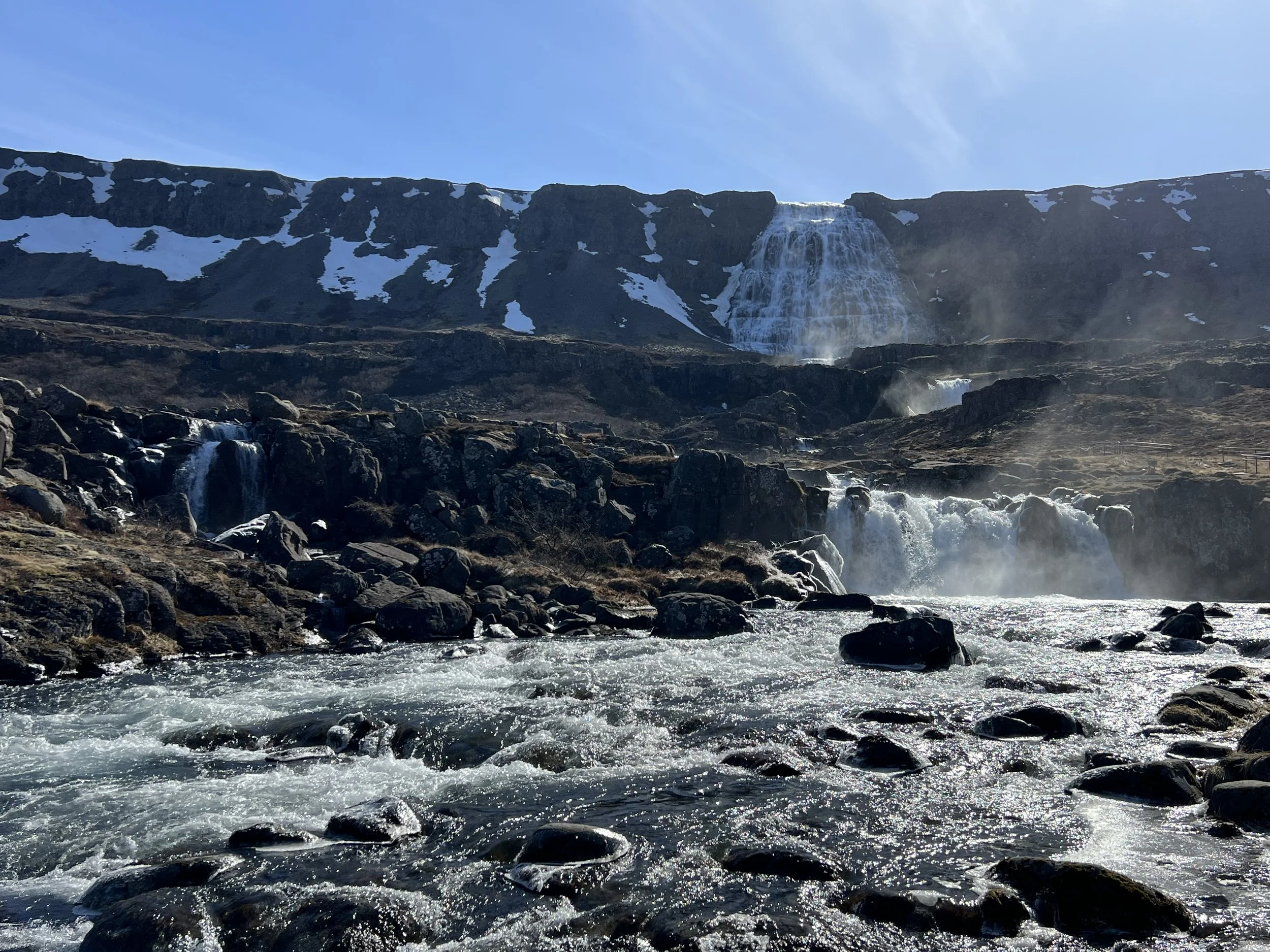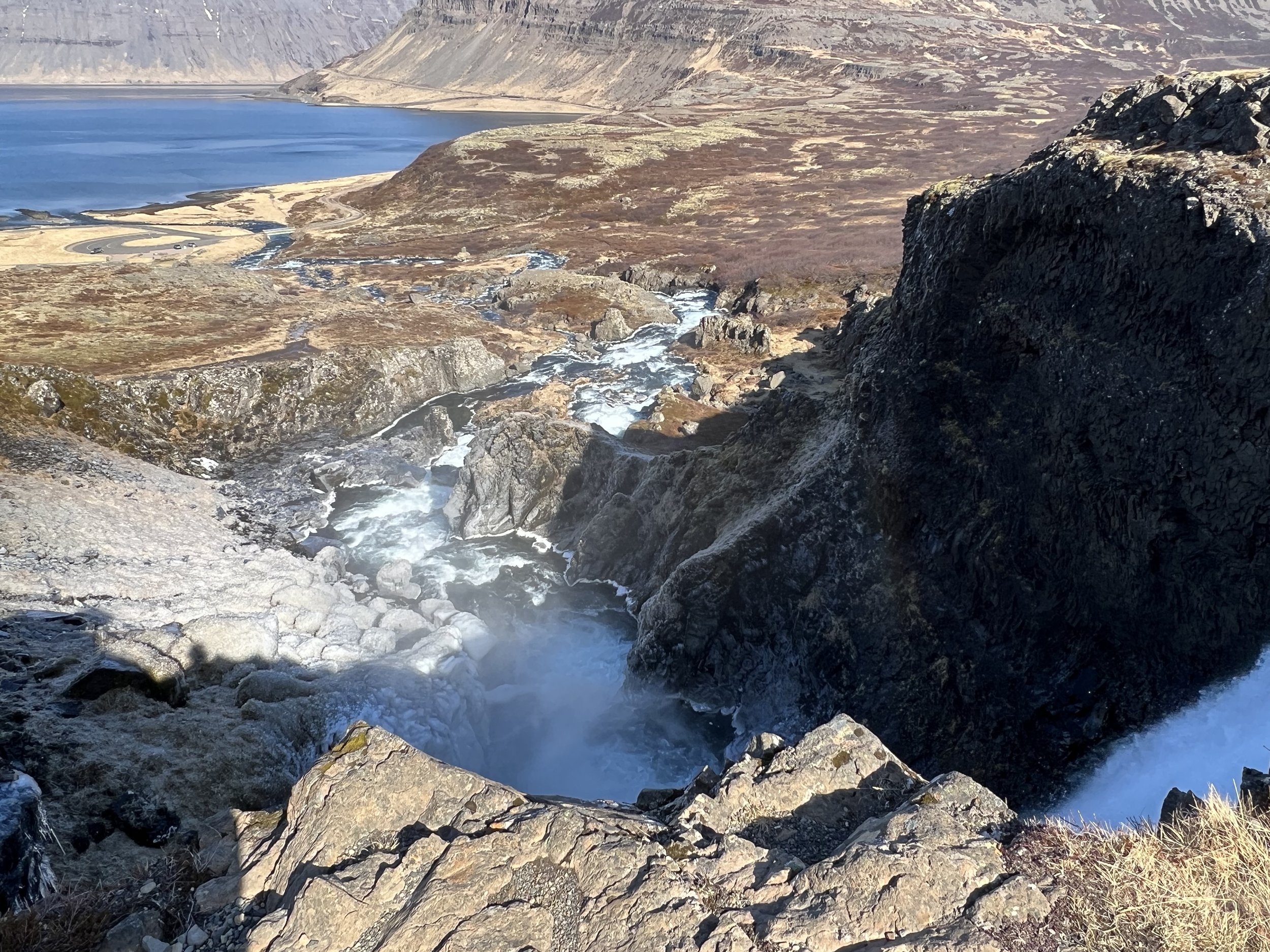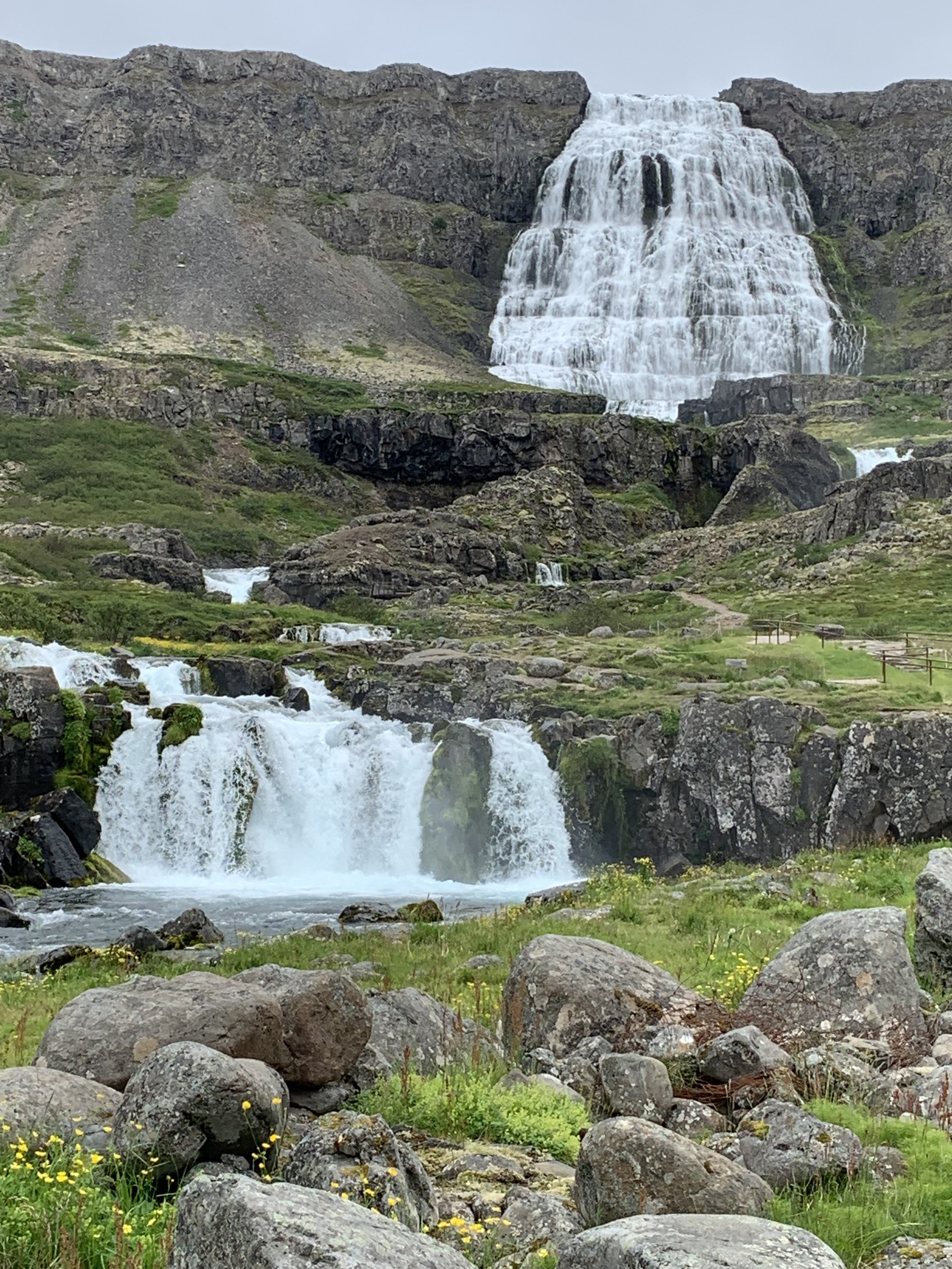Dynjandi
The glorious Dynjandi
Dynjandi is often seen as the jewel in the crown of the Westfjords.
The name Dynjandi translates as ‘Thundering Noise’ or ‘The Thundererso is very well named. It does have another name; Fjallafoss, or Mountain Falls, but the name Dynjandi is the one it is known by.
Of all the waterfalls I’ve seen in Iceland this is one of the most distinctive, due to its unusual shape. There are another six waterfalls below Dynjandi itself, forming a long cascade of tumbling water, but Dynjandi itself is by far the most impressive of all the falls, being 99m high, 30m wide at the top and 60m wide at the bottom. The shape of Dynjandi has often been likened to a bride’s veil and you can see why when you look at it, with the water resembling lace as it tumbles down the rocky mountainside.
The ‘bridal lace’ of Dynjandi seen close up
The seven waterfalls at Dynjandi make for an absolutely amazing hike – it doesn’t take very long to climb from the car park at the bottom of the series of falls up to the foot of Dynjandi itself; the hike is steep, but relatively short. I suppose it would take about 15 minutes or so if you were to set off and not stop until you got to the top – except that that isn’t really possible, as each of the falls is so different and they are so beautiful, each in their own right, that you need to keep stopping to admire the sight and to take photographs. The names of the waterfalls in order from the bottom, right up to the top are Bæjarfoss, Hundafoss, Hrísvaðsfoss, Göngumannafoss, Strompgljúfrafoss, Hæstahjallafoss and, of course, Dynjandi.
Some of the smaller waterfalls on the hike up Dynjandi
Each new waterfall is a perfect opportunity to stop, catch your breath, and marvel at the stunning scenery, both looking upwards at the meandering falls with Dynjandi at the top, downwards at the waterfalls you have passed and, not least the panoramic view of the Arnarfjörður fjord and the mountains behind you. The higher you climb, the better the panorama looks and by the time you reach the top it really is magnificent.
Whilst each of the six waterfalls beneath the main waterfall Dynjandi is breathtaking, the cumulative effect of the seven waterfalls and the scenery that they are set in is what makes Dynjandi so very special. And, as well as being very beautiful, the sound of this massive volume of water thundering down the mountain assaults the senses and adds to the overall feeling of awe.
By the time you reach this point the sound of the water is very loud indeed!
Apparently, over the centuries, the Icelanders believed supernatural beings lived in all seven waterfalls. Some people still believe it today and you can understand why as there is something quite other-worldly and intoxicating about the place.
Beautiful in all seasons, this place is quite unique
The first time we visited was in the summer so we were able to see Dynjandi in a lovely green setting, surrounded by fields and flowers. There were plenty of birds, although to be honest not much birdsong as they couldn’t be heard over the sound of the water rushing past! Looking down at the fjord below us, even though it was a cloudy day, we were struck by the lovely contrast of blue and green. And the bottom of the falls, where the ground levelled out, cross-crossed with streams, looked almost like an alpine meadow. It really is quite a magical setting.
Being the summer, it was a relatively easy climb, but obviously we shared that climb with many other people on the same hike and taking pictures. However, this last time we visited was in April, and despite there being two other cars parked at the bottom, we found we had the whole hike and our time up at Dynjandi itself, completely to ourselves with not another soul there. This is because the Westfjords don’t really open up to visitors until the summer and in fact many of the attractions, restaurants and even hotels do not open until mid-May. The weather in the Westfjords can be unpredictable and the winters are very harsh, with snow and ice still very much present on the higher areas in April.
There is still plenty of snow and ice around in April and even beyond
In fact, when we climbed up to Dynjandi, we found that there were several sections of the path that were icy and very slippery, so we had to be very careful indeed. The area at the top which gets covered in the mist and spray from Dynjandi itself was incredibly slippery and I was only able to get near the foot of the falls by holding tightly onto the rope fencing and stepping very slowly and gingerly indeed, thanking my lucky stars I was wearing my sturdy hiking boots. It would not have been possible to have done the walk when we did if we had been wearing trainers or lightweight shoes. Particularly going back downhill, where we had to avoid the many patches of ice on the path itself.
The view down the waterfall as we descended, very gingerly due to the ice
But our efforts and care were well worth it and we were rewarded by the opportunity to have this incredible place to ourselves for the time we were there – something that I imagine very few people will have the chance to experience. Standing at the foot of the ‘bridal veil’ is nothing short of breathtaking.
Matthew, holding tightly onto the rope to avoid slipping
As well as being the main attraction of the Westfjords region, Dynjandi is considered by many to be the most beautiful waterfall in Iceland. Considering how many waterfalls there are here, almost all of which are stunningly beautiful, that really is saying something. And, subjective as that statement is, it shows just how worthwhile it is to make the trip there to see it. And it can be quite a trip! From the south of the Westfjords, there is a long drive on route #60, much of it being a gravel road, that is quite mountainous and which in places seems to be a dirt track across a rocky lunar landscape! We found it quite an intimidating drive the first time we did it and, coming from the south, you cannot see Dynjandi until pretty much the moment you happen upon the car park, as you come down the mountainside from behind the waterfall. If you happen to be visiting it from the north, from the direction of Ísafjörður, the huge waterfall is visible ahead of you for quite some time as you approach. Route #60 is closed in the winter; it usually closes in late October and reopens around late April. The exact dates vary each year depending on snowfall and weather conditions, but we were lucky to be able to drive it on this last visit as, challenging as it is, it saves a lot of time not having to go back via the longer Ísafjörður route. Although not an F-road, I wouldn’t want to do it in a car that was not a 4 wheel drive.
Dynjandi seen from several kilometres away - it is quite a sight!
However, despite the challenge of getting there, Dynjandi is well worth the effort! Without doubt, one of the most spectacular sights we’ve seen, it really is something very special indeed.

